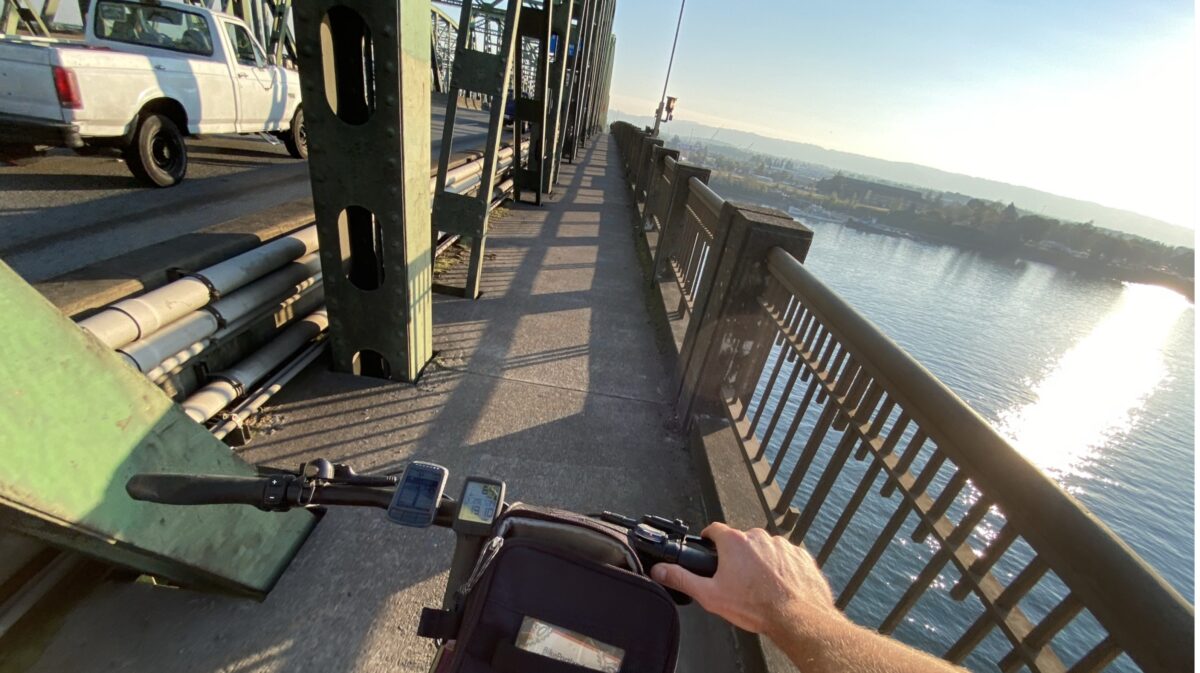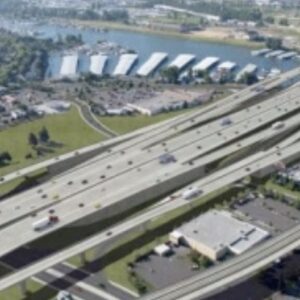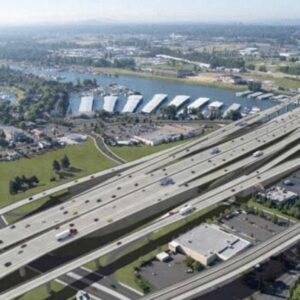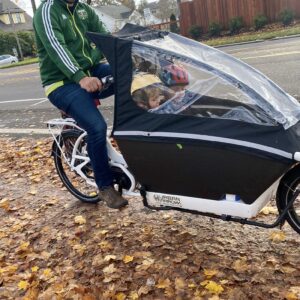
(Photo: Jonathan Maus/BikePortland)
Here we go again.
Tomorrow morning top officials from governments and transportation agencies in Oregon and Washington will meet for the first time to discuss a new effort to replace the Interstate 5 Bridge over the Columbia River. One of the six problems with the existing bridge officials want to solve is, “Inadequate bicycle and pedestrian facilities.”
If you’re new to this site or to this town, you need to know some history: Back in 2007 the Oregon and Washington departments of transportation embarked on what they called the Columbia River Crossing. It was extremely shady from the get-go and they spent six years trying to convince us that their plan to spend $4 billion to encourage more driving and widen the freeway (and several ramps) between Portland and Vancouver would be a good thing. $175 million in plans and presentations and consultant paychecks later, the project died when Washington state legislators — who were never comfortable with the idea of light rail into their backyard — voted against a bill that would fund it.
The project is now called the I-5 Interstate Bridge Replacement Program, or I-BRP (pronounced, “I burp”). Tomorrow morning the project’s Executive Steering Group (ESG) meets for the first of two kickoff meetings. Here’s who has a seat on the ESG:
Advertisement
- Oregon Department of Transportation: Kris Strickler, Director
- Washington State Department of Transportation: Roger Millar, Secretary
- TriMet: Doug Kelsey, General Manager
- C-TRAN: Shawn Donaghy, CEO
- Oregon Metro: Lynn Peterson, Council President
- Southwest Washington Regional Transportation Council: Scott Hughes, Board Chair
- City of Portland: Sonia Schmanski, Deputy Chief of Staff, Mayor Ted Wheeler’s office
- City of Vancouver: Anne McEnerny-Ogle, Mayor
- Port of Portland: Kristen Leonard, Chief Public Affairs Officer
- Port of Vancouver: Julianna Marler, CEO
- Interim Community Advisory Group Co-chair (WA): Lynn Valenter
- Interim Community Advisory Group Co-chair (OR): Ed Washington
You can follow along on the meeting tomorrow (Friday, 11/6) at 8:00 am via YouTube or Zoom (passcode 531345). They’ll have a second meeting on November 30th.
We desperately need a better cycling connection between Oregon and Washington and this is our chance to get it. Stay tuned! And if you are interested in background on the CRC, check out the 90 or so articles I wrote about it between 2007 and 2014.
— Jonathan Maus: (503) 706-8804, @jonathan_maus on Twitter and jonathan@bikeportland.org
— Get our headlines delivered to your inbox.
— Support this independent community media outlet with a one-time contribution or monthly subscription.







Thanks for reading.
BikePortland has served this community with independent community journalism since 2005. We rely on subscriptions from readers like you to survive. Your financial support is vital in keeping this valuable resource alive and well.
Please subscribe today to strengthen and expand our work.
This looks like a replay of the Governors’ I-5 Task Force, 1999-2002 on which I served.
The Mayor of Vancouver was a citizen rep on that effort. The only returning “vet.”
One bit a data I recall from early in the process was that one third of the traffic across the River was “local,” i.e. trips of just a few miles. I suggested one night that we need a “Broadway Bridge”…and eventually the TF defeated my motion for including a local bridge option in the DEIS by one vote! So much for consensus.
The OR reps need to be firm that the project must include high capacity transit (MAX if you ask me) and tolls or nothing happens. No Tolls, no transit, no new bridge! Ironically if tolls were put in place today, the congestion would go away with no new capacity at all! Joe Cortright has done some excellent reporting on that. Paint would do the rest…HOV/transit lanes on the existing bridges, which can be seismically retrofitted with toll proceeds. Transit riders pay, why not private motor vehicles?
Maybe in the best of all possible worlds we would construct a 6 lane tunnel for through traffic, retaining the existing bridges for transit, local traffic and bike/ped. By de-constructing I-5 between tunnel portals and replacing it with a grand boulevard on both sides of the River, we could begin to transform the region for the 21st century.
> Transit riders pay, why not private motor vehicles?
Transit riders pay a decent amount for a cross-river commute too: An express bus across the river into/from downtown Portland or Lloyd Center is $3.85.
C-Tran does have zones like Portland used to, so prices range from 1.80 to $2.50, and if you want to take a bus for just the river crossing, that’s $2.50 like a TriMet ticket. Every time I ride the Delta Park Express, it’s very full despite running every 15 min. I know the bridge is 70% of why I’m on the bus; how many others would have walked or biked if the bridge was easier?
My suggestion: put a new freeway bridge next to the current bridge. Three lanes each way, but with wider shoulders and much higher river clearance. And don’t be afraid to put a lift span on it; just make the bridge high enough that the lift span is almost never needed.
Give the existing bridges a seismic upgrade and use them for local traffic, bikes, pedestrians and transit.
Aligning the lift span with the lift span of the rail bridge just downstream would eliminate most of the lifts.
I’d like to see them de-couple the aspects of this project. We could do a two-stop yellow line extension (one at Hayden and one at the downtown Vancouver transit center) for $500-800 million. Bridges would include bike/ped, similar to the Tillicum. This would provide a transfer point for Vancouver’s Vine BRT and other buses to MAX, and CTran express routes could use the new bridges to bypass traffic.
I agree completely about the decoupling. An arterial/light rail bridge from Marine Drive to Hayden Island could be its own project. A new freeway-only bridge could be its own project. Fixing the lift span downstream could be its own project. Rehabbing the existing bridges for bikes and transit could be its own project.
Each project has its own independent utility, and it would make sense to advance and fund each one separately.
Vancouver doesn’t really have a downtown transit center. The old CRC plan was to build two blocks of parking garages at 4th Street. Commuters were expected to get off I-5 at 15th and wander through the downtown business district to the parking garages and MAX.
Also, Vancouver doesn’t need to lose any more of its downtown to new bridges or interchanges.
If I were planning the project, I’d replace the freeway interchange at 5th and Washington with a transit plaza. MAX could connect to all CTran buses that serve downtown Vancouver.
I think Tilikum shows that a transit/ped bridge doesn’t have the same disastrous effects as a car bridge. Businesses at both end make it seem like not much more than a normal street
That’s because hardly anyone uses it!
I think Turtle Place would count, with two Vine BRT lines:
https://www.catchthevine.com/
If you look at the potential pathways from Expo to Turtle Place, it can be done by sticking closer to the I-5 bridges, taking advantage of land that is already interchange hellscape.
Height is limited unless you are willing to lose the airport. Also has to be high enough to get some real tall stuff in and out for industry. You can’t eliminate the lift, maintain access for industry and keep the airport from what I remember from the last time around.
Tunnel, like under the Fraser River near Vancouver BC or all those in NYC?
I’d like to see the plan for keeping the resulting bike tunnel free of campers & safe to travel through. During the rainy season, that’s a half-mile of nice, warm chopshop campsite real estate.
That’s why I suggest keeping a lift span on the new freeway bridge. Line it up with the lift on the existing bridge, but make it much higher. That way, the new bridge will need to be lifted only for really tall stuff. And there are probably ways to schedule river operations so the really tall stuff passes through late at night.
How about a pivot instead of a lift? Or a drawbridge?
…like the Bascule draw span in the Common Sense Alternative II.
Join the discussion…Realize that the existing I-5 bridge has towers that have violated the height restriction relative to Pearson Airpark for over 100 years. Enforcing a height restriction limit that may compromise the utility of the new bridge (if it is similar to existing conditions) seems like an unrealistic design expectation.
Because of the historical discrepancy between what all the parties want, I hope they can discuss a least common denominator which can get built relatively soon (eg a bike/freight bridge on W Hayden). I’d be fine with that as an interim fix.
There is a great video of the compromise we were all willing to make the last time around, it is called the common sense alternative to the CRC: https://www.youtube.com/watch?v=sPB1jtmHVkk
Kind of wish before anyone says anything at this meeting, they all just watch this. Here’s a slightly longer version of the same.
https://www.youtube.com/watch?v=Md44YEDJ4bs&ab_channel=couvdotcom
I came here to post this!
Make more, and better crossing options, separate facilities for different modes, and no more single-point-of-failure crossing!
I should point out that the original CSA (shorter vid) did not include an arterial lane on the local multimodal bridge. The purpose was to remove onramps at either end of the bridge. I think Jim added this later. This means the “local bridge” has a freeway lane that solves the slow merging problem. Quite a savvy design.
We need to bombard these “meetings” and “feedbacks” with just links to this video.
Totally on board with this. I think the real reason is the federal funding is tied to interstate freeway work so most would have to be locally supported
How about we kill 5 birds with one stone: Knock down the current I-5 bridges and replace them with ferries – perfectly earthquake-proof, would slow traffic to a crawl both at the ferry terminal and on the 205 bridge, eliminate the need for the Rose Quarter freeway expansion, vastly encourage local Amtrak commuter ridership, and encourage an express ferry system to downtown. We could even negotiate with BNSF to run MAX on their tracks (they use the same width track).
I like it, but I’d like to see a Tilikum style bridge replace the I-5 bridge with transit and active transportation instead of trying to get light rail on the BNSF bridge.
Ferries are only as earthquake proof as the bridges they pass under.
Wasn’t the Federal government threatening to claw back their portion of the wasted funds from the first debacle? I’m pretty sure they never did. They should claw it back, doing the right thing for the American taxpayer, and putting Oregon and Washington on notice that they cannot waste money again. Fool me once, shame on you…fool me twice, shame on me.
They only wasted $110 million on CRC. You should see what they waste in other states, usually far more, but that’s nothing compared DC-area projects such as transit to Dulles – study after failed study over a 60-year span, finally resulting in a $5.7 BILLION surface “subway” line on a highway median. There are many contractors who specialize in successfully wasting our tax dollars, a whole major industry. And we are all suckers for it.
I think that’s one reason for the push to restart the bridge discussions. To avoid having to pay that money back.
Joe Cortright argues this was a lie.
https://cityobservatory.org/no-deposit-no-return-another-lie-to-sell-the-columbia-river-crossing/
This was a lie. (h/t to JaredO for sharing Joe Cortright’s piece).
It seems this “factual inaccuracy” (at best) is still pervasive. Here’s the Columbian this week, parroting without fact-checking project administrator Greg Johnson:
Source: “I-5 Bridge replacement group outlines role, timetable”, by Anthony Macuk, Columbian business reporter. Published November 7, 2020, 1:39pm (I’m not going to add a link to an inaccurate article, but you should be able to Google this title if you want to see it.)
Jonathan, has Cortright’s debunking been shared much on BikePortland? It seems like a quite valuable piece of misinformation-busting. A couple key quotes below.
From the Federal Highway Administration itself:
Cortright explains:
As you may remember, as it was struggling near the end of CRC 1.0, ODOT specifically renamed the Columbia River Crossing the I-5 Bridge Replacement Project *BEFORE* it died.
This version is not a new brand, but the old (“improved”) brand reused. Example here:
http://data.wsdot.wa.gov/accountability/ssb5806/Repository/6_Project%20Development/New%20Starts/OR_LEG_021113_Presentation.pdf
ODOT clearly did that to rebrand this project as something popular (replacing an old bridge) rather than what it was: mainly a highway expansion project (five or six interchanges, lanes, etc.)
Cycling and ped over the I-5 bridge should not be a reason or justification for the several billion dollar project that this threatens to become.
That is becoming a standard trick by the powers that be. Earmark 1% for bike/ped and market that as bait to get voters to swallow the other 99% that is mostly highway/freeway.
Anyway, there already is cycling/ped access, I rode over the bridge 3-5 x week for about four years (lived Portland, worked Vancouver). I can report that it is “okay” – takes a few times to get used to it, then the bridge is the nicest part of the commute, and most of its issues could be easily addressed with very minor work. The biggest issue is the growing homeless impact on the bridge approaches. That’s not an infrastructure issue; it exists only on the Portland side.
I suggest that the two existing spans of the I-5 bridge be RETAINED. AND, add two new spans, at least 3 lanes wide each, one east and one west, of those. Eventually, if it is deemed necessary to replace the existing spans, re-use their foundations for additional spans.
And: Get rid of the Davis-Bacon law, which essentially requires that union wages be paid for projects such as this. (Or make it inapplicable to this project).
It’s disappointing to see a bike blog enthusiastically supporting a multibillion dollar fossil fuel project due to a few “crumbs”. It’s abundantly clear that, like “people who drive”, many “people who bike” are ignoring the climate emergency.
I strongly disagree that BikePortland is “enthusiastically supporting” this project.